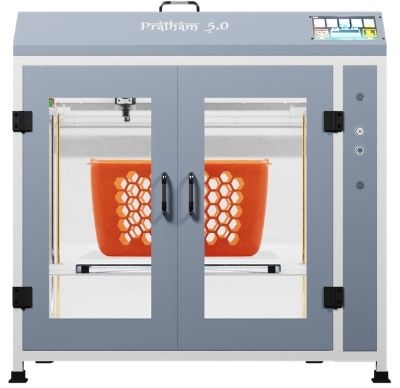Large-format Pratham X 3D Printer Launched in India
The Indian 3D printing market is sizzling with activity. From new space startups and additive construction to education, the landscape is bustling. Big names like HP, Siemens, and Roboze are planting roots, and indigenous companies are rising. Among them, Make3D is making waves with the release of its Pratham X printer, a behemoth material extrusion system with a 1000 x 1000 x 600 mm build volume. Weighing in at 250 kilos, this machine is built to be a manufacturing powerhouse “Made in India.”
The Pratham X is the next evolution of Make3D’s earlier Pratham 3.0 and 5.0 machines. It comes with a slew of features: automatic bed leveling, linear ball screw motion control from THK, carbon and HEPA filtration, and linear guides from Hiwin. Its metal chassis houses an aluminum build platform. The open machine is compatible with PLA and TPU, offering wireless or standalone operation. It features a 120°C silicone heated bed mat that reaches its target temperature in just 30 seconds, as well as nozzles that can heat up to 280°C. To demonstrate its capabilities, test runs have been conducted with print jobs lasting up to 245 hours. Additionally, the printer provides versatility by allowing configuration with either a single or dual extruder setup.
“We’re excited to introduce the Pratham X, a revolutionary addition to our lineup at MAKE3D. We believe that Pratham X is set to redefine 3D printing for engineering applications. In its price range, Pratham X stands out as the only 3D printer with a heated build plate, power failure job protection, filament sensor, Box for up to 3 kg filament, and Ball screw in all 3-axis. This lets you create larger, detailed parts with precision. This advancement lets you make bigger things, boosting your productivity and efficiency. For those ready to elevate their 3D printing journey, consider Pratham X from MAKE3D,” said Tejas Diyora, Business Development Manager at Make3D.
Make3D doesn’t mince words when describing its creation, dubbing it a “Monster” and a “heavy-duty workhorse.” It’s printers like these—designed to keep churning out parts—that capture my interest. Such robust systems are perfect for companies in sectors like automotive and shipbuilding, where large-scale prototyping and tooling are key.
Excitingly, if this printer performs as promised, it could find a home in various types of businesses beyond its initial target market. We’re currently witnessing a divergence in the 3D printing landscape. On one end, software-centric machines from companies like Ultimaker and Bamboo Labs are leveraging their ecosystems and software tools to enhance 3D prints, making the process more user-friendly. Ultimaker, for example, has found significant success due to its robust software experience.
On the other end of the spectrum, especially in the large and medium format sectors, a different kind of machine is emerging. These are sturdy, heavy-duty printers designed to continuously produce parts. They may lack the polish of their software-heavy counterparts, but they look perfectly at home on the concrete manufacturing floor. If these printers can offer both value and reliability, they have the potential to make a significant impact. The challenge has been creating systems that are both reliable and consistent over time. I appreciate that Make3D has sourced high-quality components for motion control to ensure this aspect of the machine is solid.
Whether Make3D will expand its reach beyond its local market is still an open question. The large-format 3D printing market is notably fragmented, and we’re seeing a trend of local production for heavy-duty material extrusion systems worldwide. This makes it quite possible that Make3D’s printer could primarily appeal to the Indian market, where it might achieve significant local success. Given the increasing interest of Indian politicians in supporting local high-tech enterprises, the conditions seem favorable for the emergence of regional or even national 3D printing champions.
Personally, I would love to see Make3D not just create an excellent system but also become an export giant that dominates the large-format space. This is a sector where both value and robustness are key factors, and if Make3D succeeds in those areas, the company could make a substantial impact. However, even if Make3D focuses primarily on serving the Indian market, that in itself could be a substantial achievement, given the size and potential of that market.
Subscribe to Our Email Newsletter
Stay up-to-date on all the latest news from the 3D printing industry and receive information and offers from third party vendors.
Print Services
You May Also Like
RAPID 2025: Stratasys & trinckle Announce Strategic Software Partnership
News continues to flood in from last week’s RAPID+TCT 2025, including a new partnership between AM market leader Stratasys and Berlin-based software company trinckle. By automating important steps in fixture...
RAPID TCT 2025: Spring in the Paris of the Midwest
I’m going to go out on a limb here and say that whomever coined the phrase Detroit: Paris of the Midwest, had not spent a lot of time in Paris...
3D Printing Financials: 3D Systems Looks to Bounce Back in 2025
After a challenging year for the industry, 3D Systems (NYSE: DDD) ended 2024 with results pointing to a reset, laying the groundwork for future profitability. The company didn’t post strong...
Printing Money Episode 27: Q4 2024 Public 3D Printing Earnings Review with Troy Jensen, Cantor Fitzgerald
Q2 2025 has already begun, but public markets reporting has only just finished with Q4 2024. To tie a bow on Q4 2024, we are thankful to have Troy Jensen...



























